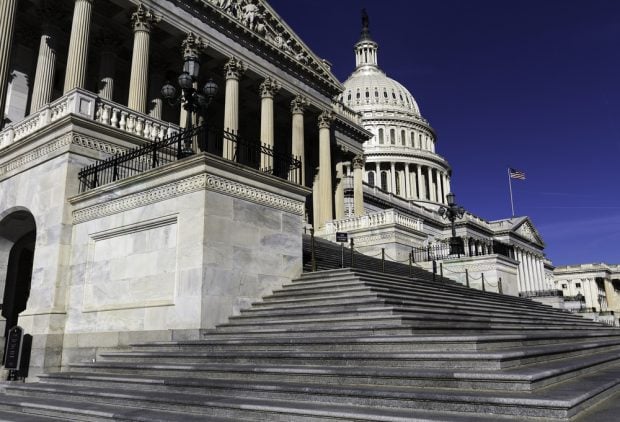Following two years of modest but positive economic growth, thepast few weeks have been unsettling. The U.S. government cameunnervingly close to a self-induced default. Real sovereign debtcrises at a number of European countries threaten another bankingcrisis in Europe. Standard & Poor's downgraded the U.S.long-term credit rating.
|Wild gyrations in the stock markets were accompanied by a recordlow rate on the 10-year Treasury bond. The Fed announced that itwill keep the federal funds rate on the floor for at least two moreyears.
|Any one of these alone would be cause for serious concern, buttaken together in such a short span they are alarming. Underpinningmost of the issues is the growing concern that the U.S. economymight be slipping back into a double-dip recession. Let's look ateach item, and then turn to the implications.
|The debt ceiling debate. Those Europeancountries verging on default are in that position because they arerunning huge budget deficits and no one is willing to lend to themanymore. In contrast, investors all over the world are more thanwilling to lend to the U.S.
|Nevertheless, we almost defaulted on our obligationsvoluntarily, when we came close to not crossing a self-imposedlimit on our national debt. Two days after the Senate vote, thestock market fell by almost 5%. That was probably due to concernabout a weakening economy coupled with investors figuring out thatany fiscal stimulus in response is politically off the table.
|European sovereign debt crises. Three of thesmaller European countries appear to be unable to meet theirobligations without a bailout from the rest of the Euro zone:Greece, Portugal and Ireland. Two larger countries considered toobig to fail are also running out of options: Italy and Spain. Thesedebt crises weaken near-term growth prospects in Europe, weakeningthe outlook for U.S. exports to Europe. More acute is the chancethat one or more of the very large European banks that have loanedsubstantial amounts to these weak countries could themselves failas a result.
|U.S. debt downgrade. As S&P describes it,the downgrade had everything to do with politics and almost nothingto do with economic fundamentals. The dysfunction revealed inCongress' inability to come to a long-term deficit reduction plan,despite the underlying strength of the U.S. economy, was the reasonfor the downgrade. Tellingly, the day after the downgrade, thestock market tanked while Treasury interest rates dove. That'scurious, because debt downgrades usually cause the debtor'sborrowing costs to rise, not to fall. In this case, investors knowthere is no chance the U.S, will default (keeping Treasury rateslow), but they also know that near-term fiscal austerity willweaken the economic outlook (reducing stock prices) and keepinflation expectations low (lowering Treasury rates.)
|Wild financial market gyrations. The recentstring of 3% to 5% daily changes in stock values are veryunsettling to households. Unless we end this volatility with aseries of positive changes restoring most of the latest declines,consumer confidence will suffer.
|The Fed's two-year announcement. The FederalReserve's announcement about keeping the Fed funds rate low untilmid-2013 has frequently been mischaracterized. What they actuallysaid was weak economic conditions “are likely to warrantexceptionally low levels for the federal funds rate at leastthrough mid-2013.” The Fed does not expect sufficient improvementin the economy to raise interest rates for at least two more years.If the economy surges before then, it will raise ratessooner.
|So what does all this mean for credit unions? The revelation ofthe past month is not that we have mounting debt problems aroundthe world. We already knew that. The real news is that the worldeconomy is weaker than previously expected, with the possibility offalling back into recession. Credit unions can expect a weakereconomy going forward because of this. The odds are still for aresumption of modest growth, but a double dip is more likely thanwe previously thought.
|The stock market's effects on consumer confidence will dampenloan growth for credit unions. With 10-year Treasury interest ratesbouncing along record lows, 30-year fixed-rate mortgages are alsoapproaching unheard of levels. Credit unions should expect a floodof refinancing of mortgages not underwater, unless rates quicklyrecover.
|The debt ceiling mess and the debt downgrade tie the hands ofthe federal government in promoting an expansionary fiscal policyat a time of economic weakness, further lengthening the time untileconomic recovery. The overwhelming majority of mainstreameconomists understand that in an economy with substantial excesscapacity (high unemployment), fiscal stimulus will get an economyback on its feet faster, or at least will slow furtherdeterioration.
|Most of us economists believe that what's needed now is a dualpolicy: short-term fiscal stimulus coupled with long-term changesto entitlements and revenues to bring future deficits down. Thefiscal stimulus would promote immediate growth.
|The long-term deficit reduction would encourage expansion by aprivate sector not burdened by fears of future deficits.Unfortunately, the first part of this strategy is politicallyverboten, and the longer-term portion seems for now to be beyondthe ability of our elected officials.
|Bill Hampel is chiefeconomist for CUNA.
Complete your profile to continue reading and get FREE access to CUTimes.com, part of your ALM digital membership.
Your access to unlimited CUTimes.com content isn’t changing.
Once you are an ALM digital member, you’ll receive:
- Critical CUTimes.com information including comprehensive product and service provider listings via the Marketplace Directory, CU Careers, resources from industry leaders, webcasts, and breaking news, analysis and more with our informative Newsletters.
- Exclusive discounts on ALM and CU Times events.
- Access to other award-winning ALM websites including Law.com and GlobeSt.com.
Already have an account? Sign In
© 2024 ALM Global, LLC, All Rights Reserved. Request academic re-use from www.copyright.com. All other uses, submit a request to [email protected]. For more information visit Asset & Logo Licensing.









